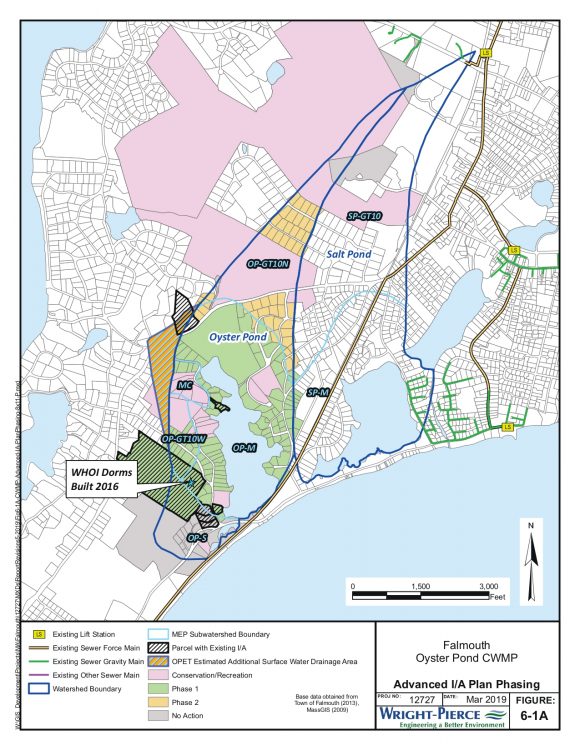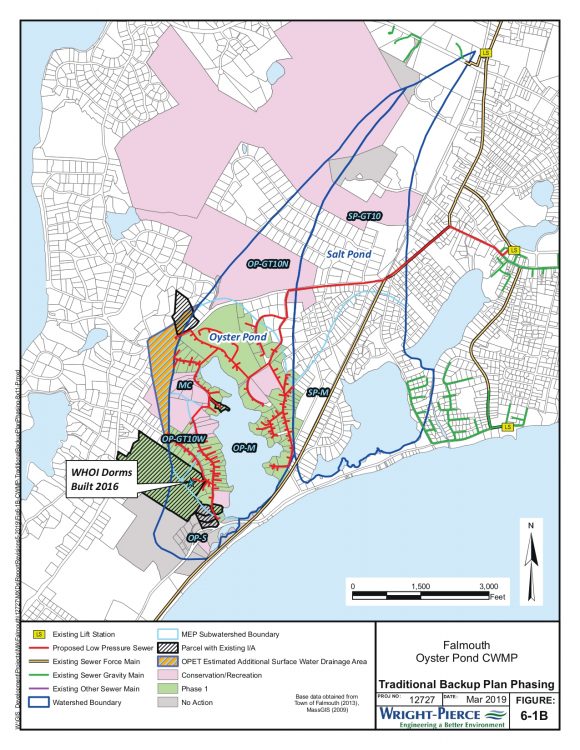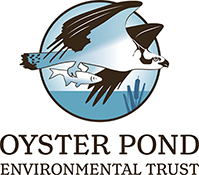Two Town Plans to Clean Up Oyster Pond
We hope you were able to attend the Town’s Water Quality Management Committee (WQMC) meeting regarding the Comprehensive Wastewater Management Plan for the Oyster Pond Watershed held on October 5, 2019 at SEA Education. It was good to see that over 50 people attended, proof to the WQMC (the Town committee tasked for developing CWMP plans for the impacted estuaries in Falmouth) of the keen interest in the plans for the Oyster Pond neighborhood.
Here is a brief overview of the highlights of the meeting. We thought this would be helpful for both the residents who were unable to attend and the attendees. A lot of information was discussed.
Plan 5 – The “Preferred Plan” Advanced Innovative and Alternative (I/A) septic systems – 189 parcels would be required to convert their existing septic systems to an Advanced I/A in the first phase of the plan. If this first phase did not remove enough nitrogen to the needed level to return the pond to a healthy ecosystem, then an additional 44 units would be required to upgrade to an Advanced I/A in 2039. This is the Preferred Plan chosen by the Town, because they want to explore the possibility of using these advanced septic systems across a watershed for wastewater treatment. If the Town had picked the sewering option as its preferred option, then the DEP would not allow the Town to investigate using I/As.

Plan 5, the Advanced I/A plan, will be implemented in two phases. Phase 1 is the green colored area and the start date would be in 2025. If needed, Phase 2, which includes the yellow colored parcels, would start in 2040.

Plan 1 – The “Traditional Backup Plan” – Sewering – 189 houses would be connected to a grinder pump system since gravity sewers will not work in the topography of the area. This plan will be used if the state DEP rejects Plan 5.
- Notification to Area Residents – several people were dismayed that there has not been more outreach by the Committee and the Town about these plans. The Town was urged to do much more to engage the public. Mailings and other outreach are needed.
- What if my septic needs to be upgraded before a Plan is selected? – Once Town Meeting has funded a wastewater project for the area, the Board of Health will work with homeowners to help them until they can either hook up to a sewer or install an I/A. The WQMC will recommend that I/As which have been installed prior to 2024 and that are in compliance with the nitrogen standard be grandfathered in, even if the Town chooses a different type of I/As system.
- A Question of Fairness – Some questioned why, in the case of I/A systems, the costs are the same per household no matter how many people live in the house. They asked why a two-person household should have the same costs for inspection and monitoring as a five-person household. Or if someone has natural landscaping and no lawn versus someone who uses lawn fertilizer, which can add nitrogen to the pond, pays the same. This is unlike sewers, for which the annual costs are based on water usage.
- Emerging Contaminants – Do I/As remove endocrine disrupters, flame retardants and other chemicals that are now being recognized as a public health concern? Is this is being studied and will it be considered as part of the final decision? The sole focus of the WQMC is to reduce the level of nitrogen in Oyster Pond to the mandated threshold. Consideration and reduction of other contaminants in wastewater will depend on whether there are new requirements adopted by the state or federal government prior to the final decision.
- Timeline – By 2024, the Town and DEP will look at all the data and make a final decision on what plan to use. There are many steps along the way before that point. First the DEP will decide whether to permit the “Preferred” I/As septic system proposal. If so, then the Board of Selectmen must choose which plan to recommend. The chosen plan goes to Town Meeting for a vote; then it is placed on a Town wide ballot.

